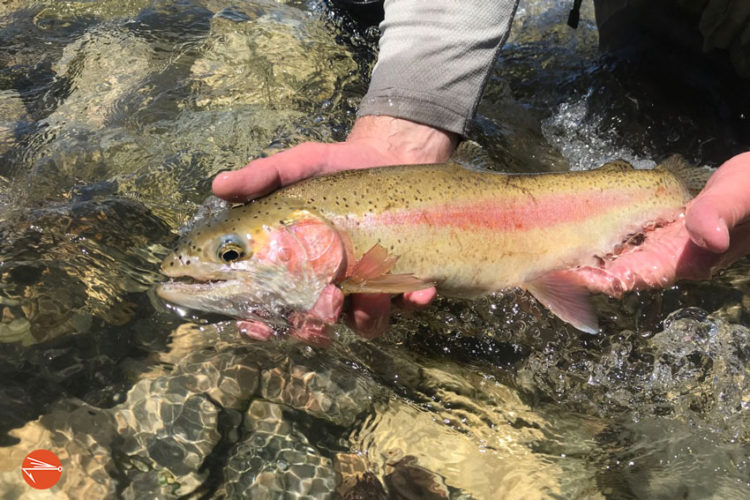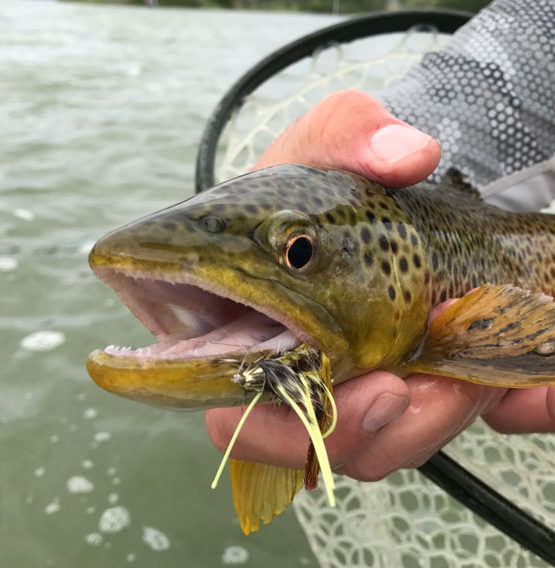In the world of fly fishing, catch and release is common practice. After all, if we want to maintain the health and productivity of our fisheries for years to come, allowing trout to their natural habitat is in the best interest of the sport. That’s also why, as an angler, it is imperative that you learn how to properly handle trout.
And while landing, handling and releasing trout properly might seem like a straight-forward process, there are potential pitfalls you should try to avoid.
So, for the rest of this guide, I’m going to cover 10 effective tips to help you properly handle trout.
Let’s get started!
Disclaimer: This post may contain affiliate links, meaning we will receive a small commission (at no cost to you) if you click through and make a purchase.1. Keep The Fish In The Water
Quite simply, you’ve got to make sure the trout is submerged as much as possible if you plan to release it. This might seem a bit obvious, but since trout will suffocate when held outside the water for too long, minimizing air exposure is key to keeping the fish alive and healthy.
Additionally, when you have a fish in your net, it is best to hold it underwater. This will allow the trout to breath while you set your rod down, fumble for your camera and fix your hair for that perfect ‘grip-n-grin’ photo you have in mind.
Just don’t let your net dip too far below the surface of the water. You want the fish to breath, not escape.
2. Avoid Over-Playing The Fish
When a fish is hooked, it’s going to do everything it can to survive. It will thrash around and tire itself out — remember, it doesn’t know that you intend to throw it right back. The best way to avoid overplaying your catch is to be prepared.
For example, if you know that you will be fishing in an area rich with large trout, use a heavier weight rod. Also, opt for the strongest possible leader you can use without spooking the fish. This added strength will allow you to bring the fish in a little quicker, and therefore, reduce its risk of over-exhaustion.
Related Posts:
- How To Hold A Trout For Photos
- How To Cast In The Wind: 7 Simple Tips
- How To Take Care Of Your Waders (10 Simple Tips)
- Top 10 Wading Tips To Keep You Safe (And Dry)
- How To Set The Hook When Fly Fishing
3. Take Your Photos Quickly
If you catch a big, beautiful trout, you are probably going to want to capture the moment. And trust me, I’m all for that. (After all, you have Instagram followers that you need to please.) That said, there is a right way of going about it, and a wrong way. And speed is the name of the game.
In other words, keep your phone or camera nearby and accessible. That way, when it comes time to take a photo, it only takes a couple seconds to snap that pic.
Additionally, whenever possible, try to photograph your catch while holding it over water instead of a hard surface. Since we’re all guilty of accidentally dropping a fish here and there (I have a few too many photos to prove it), try to avoid holding it over a jagged granite boulder, or the bow of a fiberglass drift boat riddled with crushed beer cans. (Those were two weirdly specific examples.)
4. Wet Your Hands Before Grabbing The Fish
Whenever you are handling a trout (or pretty much any other species of fish) it is best to wet your hands before picking it up.
Why?
Because dry hands are known to remove the protective, slimy coating that keeps trout safe from bacteria and other fungal infections. So, while picking up a trout with dry hands might not cause much immediate harm, it can cause irreparable, long-term damage to the trout’s skin after you release it back into the water.
5. Crimp the Barbs On Your Hooks
If you plan to release your trout after catching it, it’s important to make the hook extraction process as minimally invasive as possible.
The best way to do this is to crimp your barbs while you’re rigging your rod. This is really, quite simple.
Using a pair of long-nose pliers, or your forceps, press down on the barb so that your hook can be extracted from the fish’s mouth as easily as possible. Once caught, this will allow you to remove the hook from the fish’s mouth quickly, and release it without putting much stress on the fish.
6. Use A Rubberized Net
Like wetting your hands before picking up a fish, using a rubberized net will protect the fish’s slimy coating, and therefore, will not leave them vulnerable to parasites, fungal infections and dangerous bacteria.
Beyond that, with a rubber net, you don’t have to worry about your hooks getting caught and tangled like they would in a more traditional net. This, in turn, reduces the amount of time it takes to unhook and release a fish once you’ve netted it.
7. Don’t Touch The Gills
Again, fish out of water are particularly delicate––so, if you are planning to release your catch, you want to ensure that you are very careful in how you handle it. Don’t hold heavy fish by the mouth as this may damage the jaw and vertebrae. And more than anything, steer clear of their gills.
The gills of a fish allow them to breathe underwater. So, if you damage this essential organ, there is little chance that the trout will survive.
8. Revive The Trout If It’s Tired
One of the most common reasons some fish die once they are released is exhaustion. After a tough struggle, and receiving too much exposure to the open air, their blood can lose significant levels of vital oxygen and it will have little energy left to swim away––even after they are returned to the water.
If your catch needs reviving after tiring itself out, hold it upright in the water with both hands under its belly. Gently move the fish back and forth just below the water’s surface. This allows the oxygen in the water to flow through its gills, thus bringing it back to life. Release your grip once it decides for itself that it is ready to swim away (you’ll know it’s time when it starts wriggling again).
9. Be Gentle (Don’t Squeeze The Fish)
It’s very easy to underestimate your strength when handling a fish (even a large trout). Therefore, it’s important to remember that their bodies (and internal organs) are extremely delicate and fragile.
So, whether you’re holding a fish for a photo, removing your fly from a trout’s mouth, or attempting to revive an overexerted catch before releasing back into the water, be sure to not apply too much pressure to the body.
Related Posts:
- Buying A Fly Rod: 5 Key Considerations
- 25 Proven Tips To Catch More Trout
- 5 Easy Ways To Tell What Trout Are Eating
- 10 Best Midge Patterns For Trout
- How To Read A River: 9 Tips To Catch More Trout
10. Keep the fish calm by turning it upside down
It might sound strange, but holding a fish upside down is actually the best way to keep it calm when outside of the water.
Since the inverted motion prevents excessive flailing, it makes the process of removing the hook much easier, and will allow you to release the fish quicker.
And as I mentioned earlier, the quicker you release a fish back into the water, the less harm you will cause it.
So, did I miss any tips for proper trout handling? If so, be sure to add them in the comments below. We are all about ensuring the longevity, health and productivity of our fisheries here at Fly Fishing Fix, so if you have any additional tips you can provide for our readers don’t hesitate to throw them into the mix!
Also, if you found this article helpful, be sure to subscribe to Fly Fishing Fix! We are on a mission to build the world’s biggest, coolest, most awesome community of anglers, and we want you to be a part of it. Unless, of course, you don’t like fishing. In which case, you might want to consider talking to a doctor, or other professional that’s equipped to help you through such a debilitating ailment.











I never knew how to calm a fish but i am surprised by this information, loved it! 🙂